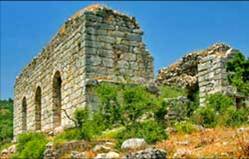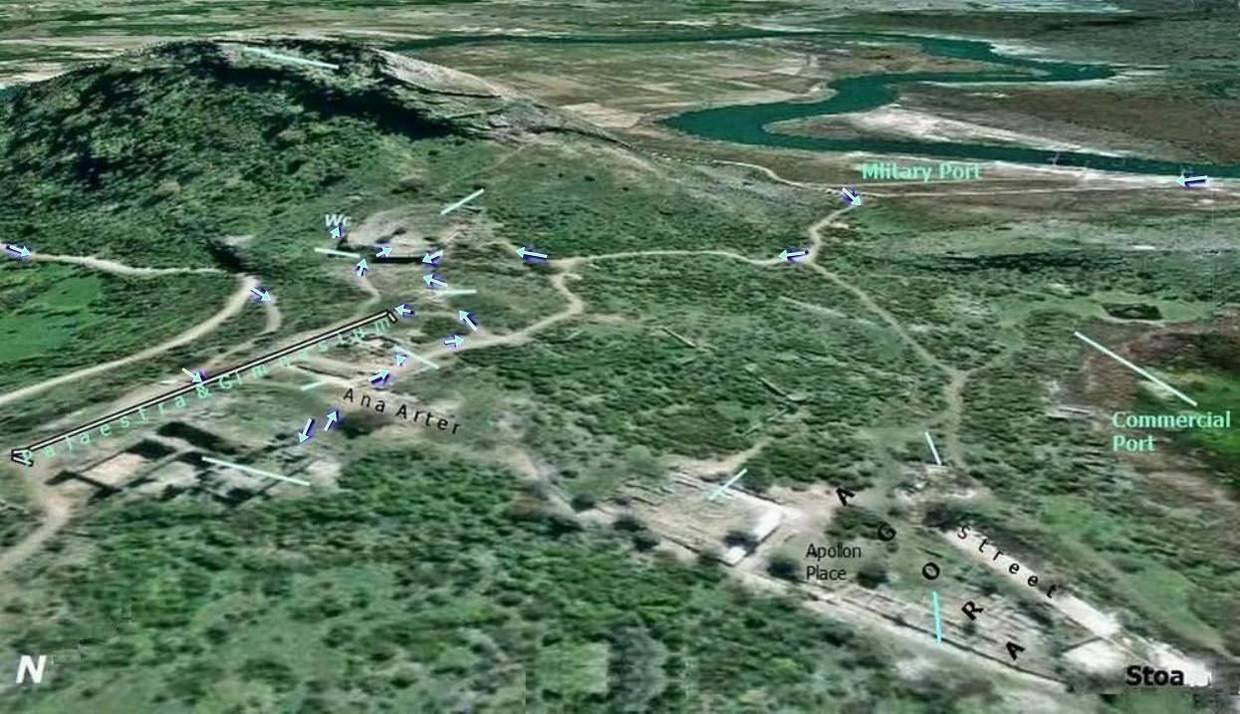
The Terrace Temple : During the ancient era, there were many gods of religions. People who lived in this area believed in Zeus, Aphrodite, Artemis and Apollo. In some antique cities people chose a god or goddess that would protect their city. In an inscription was found at Caunos, the names of Apollo, Poseidon, Artemis and Aphrodite are mentioned. Heredotos said that people of Caunos worshiped their own gods and not gods. Archaeologists found six temples at Caunos. Four of them belong to the Roman period and two of them belong to the Hellenistic period. The temple was built during the second half of the 1st century BC, on an artificial terrace dominating the agora and the harbor. It has a northeast-southeast orientation and an in antis plan with exterior measurements of 9.60x6.78 m. |
|---|
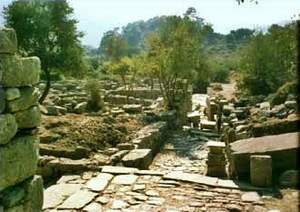 |
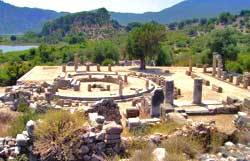 The Terrasse-Temple CAUNOS |
|---|
| The apse to be seen lying to the southeast of this building, belonged to a three-naved church which was built in the 5th or 6th century AD. The temple consists of a front space (Pronaos) containing two Doric columns between its side walls and an approximately square sacred room (Cella). The courtyard of the temple, which measures 30.50x35.00 m. was enclosed by a colonnaded gallery built of sandstone. This was originally coated with plaster and painted. According to the inscription on the cylindrical column drum at the western end of the Courtyard (Temenos), the temple was dedicated to Zeus Soteros.
|
|---|
 |
|---|
It was determined that the elements in marble and stone, used here, were not original and they belonged to other structures. Most likely, other temples must have been under this temple. Just next to the altar they started to open a borehole to investigate the background of the temple and to date the filling of the place. They soon encountered a surprise ; a monolith, sitting on the bedrock of about 3m50 tall, appeared about 6m50 below the floor of the temple; an ancient block of stone broken in two, slightly chipped pyramid. The upper part was lying to the south. |
|---|
 |
Around the base of the rock, they found waste of ashes, animal bones, pottery fragments and a large number of colored stones. Those are evidence that this rock was a symbol of a god. It was realized that the black ceramics dated by the IV. or -V. century BC. When the sacred stone was completely covered with earth the new temples are built on it. But each time, the altar has occurred almost on the sacred stone. The Baitylos, which was the symbol of the city, represented on the coins of Caunus until the middle of the Classical Period, is a non-figurative representation of Basileus Kaunios, the god-king of Caunus. This stone had great significance in the religious life of the Caunians and this sacred stone was the underlying reason for the successive constructions on this spot: of the round structure, of the temple and even of the Christian church built upon this terrace. |
|---|
Acropolis - Forteress : The elevation of the limestone mass of the greater acropolis is 152 m. above the sea level. Its southern, southeastern and eastern faces are as steep, forming a rock wall, while its northwestern and western sides are quite precipitous. The path, which began on the slope to the east of the theater was the only access to the acropolis in antiquity and climbs to the highest terrace. The garrison building lining the north side of the terrace must have been constructed, together with the cistern cut into the rocky slope to the south, during the Middle Ages. The surviving remains showing the settlement and use of the acropolis during antiquity are mostly on the terraces extending from the area below the peak towards west. The remains of the wall, constructed of large polygonal blocks lying below the Byzantine terrace walls, which are preserved up to the crenellations, and also the cistern lying to the east of the gate providing entrance to the terrace, are the traces of the earlier periods of the acropolis's use. The peak is a rather rocky hill descending with a discontinuous silhouette towards the west. The remains of a north-south oriented wall to the east and block cuttings at the north and south edges of the uppermost flat area, on which a survey triangulation point is located today, indicate the presence of a 15x35 m open-air sanctuary on this peak. This sanctuary was used for the cult ceremonies of Basileus Kaunios which were performed under the open sky. The fortress, which dates lately during the Crusades and transformed into a castle by the Knights of St. John, was built (in the XIVth century) on an older fortress but not dated. After the conquest of Rhodes by Sultan Suleiman the Magnificent, the Knights finally leave the Eastern Mediterranean on 1 January 1523. |
|---|
| CITY RAMPARTS : Apart from the ramparts that surround Acropol, there are also ramparts surrounding the city. The ramparts extend through Balyklar Mountain in the south and southeast, through the smaal fortres in the north and northwest, through Çömlekçi Hill in the west and through the region that overlooks the town of Dalyan in the south. The city walls were erected during the reign of Mausolos in the 4th century BC but restored in different periods. The height of the ramparts is a few meters at some points. The remnants of the doors inside the ramparts are visible. The regularly-shaped rectangular blocks and the way the blocks |
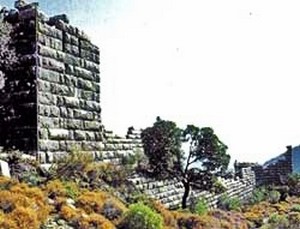 have been positioned, give a fine impression of Hellenistic building techniques. Parts of the wall are well-kept, other parts have been taken down and rebuilt. It is still not understood, how they got to move these large blocks there, with which technology they have carved and removed at a height of several meters, and bricked walls. |
|---|
Palaestra Terrace & GIMNASIUM : The flat area lying between the Measurement Platform and the Roman Bath conceals the earlier settlement layers which date from the Late Archaic period onwards. The most important among these earlier structures is a sacred precinct. The remains of its terrace walls, which were repaired several times, were discovered in the soundings excavations made around the church.The well, in front of the remains of the northwestern terrace wall and the remains of a wall found at the lowest level of the excavation suggest that this terrace area was widened and completely developed by 600 BC. A street paved with cobblestones, which was found at a quite level to the north of the area, ascends from east to west. This street, which was certainly constructed by the end of 3rd century BC, connected the city center to the ancient cemetery, including the rock-tombs. This street lost its function around 100 AD; the area was filled to make a terrace. In the east of the bath a sports school (Palestra), from the Roman period, extends towards the church. There were schools in each city to prepare young people for life and war. Military education and culture was conducted always together. Undoubtedly, athletic competitions, training and practice in wrestling and other athletics were held here. The Palestra that covers a large area is not available today. |
|---|
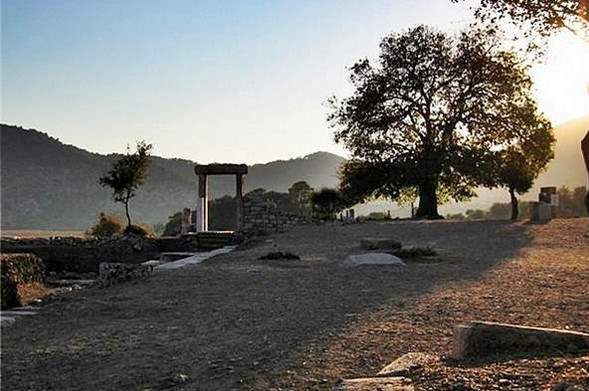 After a monumental gate (restored to its late antique phase), the east-west street wich through the terrace of Palestra, down to Port-agora as a paved road. |
|---|
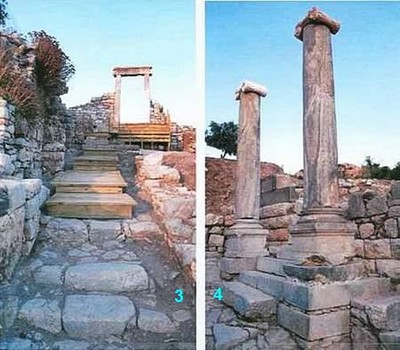 |
Photo3: The artery of the east-west connecting the terrace of Palestra, the agora of the port. This paved street is sacred and at the beginning of landing a monumental gate has been restored.
Photo4: Down on the side of the same sacred road is located a building called 'Villa'. The monumental entrance of the building recently restored and a missing column header is copied from the original, with the help of the mold. |
|---|
The Fountain of Theatre : The Theatre Fountain of Caunos takes place within the tail of analemma wall of the theater. It is a construction of a monumental fountain of 10.60 x 6m, built here in the interior of a large niche (11.80 x 3.15) with a single arc. For the construction of the structure used columns and marble blocks of lilac. The structure with two columns located between the two side walls, in-antis plan, was put in the form of a niche in the wall of the theater. This wall continues from above the building with three large arches.At that time, used to human trafficking to the upper terrace of the city; An estimate can be made, for now, only on the date of construction of the fountain: Late Classic Period (400-300 BC). |
|---|
 The fountain, until recently, remained unnoticed under the ruins of the wall of the theater; A section on the left of the north entrance gallery of the theater was destroyed. For years, archaeologists have searched and finally found the cause of degradation. Underneath, a monumental fountain building was revealed and the water, gradually weakening the field, had caused the collapse of the wall. |
|---|
The Roman Bath : The Roman baths served as a social meeting place and were intended to impress the Caunians. The Romans went to the baths for hygiene and comprehensive care of the body, but this place was also an important social function. The baths were part of Roman urban life; not only they washed, but also met their friends, made sport, played a game of dice, could conduct business there. Public baths played an important role for general hygiene. They belonged to the state or to private persons. The entrance fee was nominal. Often, to be argued, the rich burghers |
were building luxurious baths that they were free to the public.
|
|---|
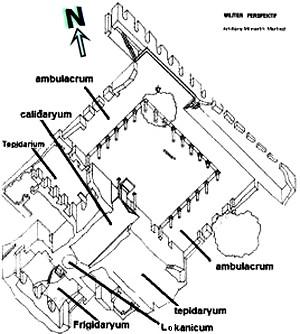 |
The bath building, which measures 58.20x28.20 m, consists of large halls. The two warm halls (Tepidarium) and the two exercise halls (Ambulacrum) were on either side of the hot room (Caldarium) and the sweating room (Laconicum) which form the middle axis. All these rooms are crowned by the cold room (Frigidarium) to the southwest. Each of these halls were originally paved with thin marble slabs. In the Byzantine period, the baths were dismantled and the frigidarium was re-used as a church. The sections of undressing, cold bath, warm bath, hot bath, oiling, heating system and a swimming pool, which became ruins over time, are now being restored. |
|---|
| We knew that the Romans were going to bed in their clothes on, but after work, they were usually to the baths to relax. They came with their servants. First, they would drop their clothes in the changing room (apodyterium, or spoliatorium) guarded by slaves, they were warming while playing sports (ball games, running, weightlifting, etc..) in the gym, because the Romans thought it evacuated the crass and those who did not like the physical effort went into the tepidarium, warm room, and then heated in a room over the laconicum (the dry sweating room) or the Sudatio (oven humidity) which is 60 ° C, made them sweat as much.. Then they went into the caldarium, |
|---|
| where they got rid of his sweat with a strigil (scraper iron or ivory), and then they went to frigidarium through the tepidarium (to avoid hypothermia), this served to strengthen their skin. They would eventually swim in the Natatiopiscine. The bath was then completed, they rested in the caldarium, and they could get a massage with perfumed oil and take tweezers. Generally, they cover his body with oil in the destrictarium (the Romans did not use soap). |  |
|---|
| [The apodyterium (plural: apodyteria) (changing rooms), the sudatorium (sweating room), caldarium (hot bath by sprinkling or immersion), the tepidarium (warm bath) the frigidarium (cold bath).] Oils and perfumes were kept in an unctuarium. The baths were not mixed, with very few exceptions (the end of the Roman Empire, the baths have become mixed). Some installations were doubled, with a separate section for women. Others practiced alternate schedules for each sex. The morning is more likely for women, while men took advantage of all the afternoon and even at night. |
|---|
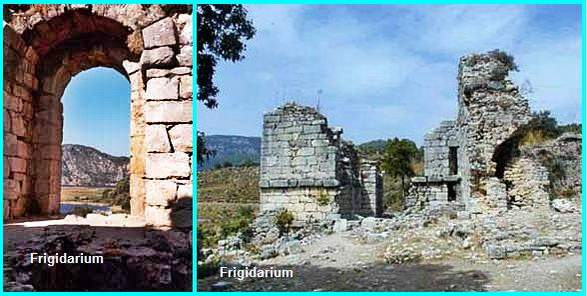 |
|---|
Today, from a structural point of view, the most characteristic side of the building, have thick walls and the niches. The construction was carried by the external walls of 3m in wide. The hewn stone walls, in a manner quite regularly in the parts below, disorderly towards the upper part (by using small stones) are constructed with the technique of masonry mortars. The superstructure of the building is not standing. On one side of the axis, (direction of the church), which is accepted through (to the Northeast to Southwest) the middle of the building, (of 1.5 to 2m high), has collapsed after a certain height. The southern part, which is the most beautiful part of the bath, is composed of many windows. From these windows you can see the city and harbor. |
|---|
At the Roman baths, were used the Hypocaust system for heating the building and the pools. This under floor heating system had hot air heated from the basement fires flowing between the brick or concrete columns which support the ground floor. The floor tiles have been removed to expose the empty space through which hot airs flowed, heating the tiles. The warm air flows through wall ducts into the rooms at the baths and quickly heats them. |
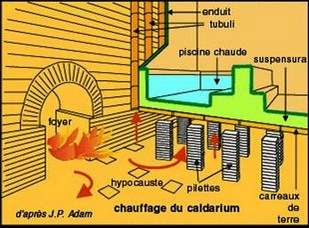 |
|---|
| In some baths the floors would be so hot that the bathers would have to wear wooden sandals to stop their feet from being burnt. There is not a museum in Dalyan and the finds are exhibited in museums in the surrounding towns. The building of Roman Baths will be transformed into a museum without touching the remains with a new project, and will be open to visitors. |
|---|
The Measuring Platform : The wind measuring platform dates back to 150 BC and was used for city planning. According to the archeologists Öğün and Işık, it must have consisted of a circular building with a base diameter of 15.80m and a top diameter of 13.70m. Upon the surface of the elaborately carved and finished block of the uppermost step a geometrical network was formed by stone cutting of: 20 radials, 3 circles and 16 sectors. The building has collapsed, however, probably as a result of an earthquake.The measuring method is therefore not quite clear. In De architectura by the famous Roman architect Vitruvius, it is stated that wind measuring platforms were used to plan streets in accordance with the prevailing wind direction, in order to keep the air in cities clean. Or an animal mooring place! ; One can even assume that this platform can be used as a place of sacrifice where, at religious ceremonies, they tied the votive animals. |
|---|

The Theater : The Theater of Caunos was built, with a seating capacity of approximately 5,500, on the western slope of the Acropolis. Its plan follows the Hellenic tradition. It consists of three sections; The stage building, an orchestra of beaten earth and the cavea (seats). Today, except for the stage and certain parts of the cavea, the theater is in good condition. Most of the mass of the theater rests upon the slope behind. A section of the northwest side rests on the supporting wall that clasps the cavea. The auditorium (Theatron; Cavea) with a diameter of 75m and rising at an angle of 27° is divided into nine segments of seats (Kerkides). Each segment has 33 rows of seats. These rows are divided into two sections with a horizontal passage (Diazoma) dividing the whole auditorium horizontally into two. The cavea can be considered as having been covered with a wooden roof to the middle. |
|---|
 |
|---|
Its orchestra has a horseshoe form and is on the same plane as the lowermost row of seats. Access to the orchestra is provided by two entrances, one, a side entrance (Parados) from the northwest and another, with steps cut into the bedrock from the southeast. The two vaulted passages opening directly on to the Diazoma are thus of a Roman character. The theater has a low stage building (Skene). The Skene measures 38.5x10.40 m and was originally two storeys with five doors and was paved by the plates of stones and marbles. The facade of the building was decorated with columns, niches, |
|---|
statues and other decorative elements. However, its height never reached the uppermost level of the theater. The uncovered side entrances are not perpendicular to the orchestra. |
 |
|---|
| The high platform (Proskenion) in front of the facade of the stage building facing the auditorium was used for performing plays and it was built in the Hellenic tradition, as it is parallel to the orchestra, with its wings parallel to the side entrances. This is a series of sculptures in the line of its junction with the orchestra. Of these, only the bases remain. Faced with these bases, in the middle of a circular pad, was opened a mortise. 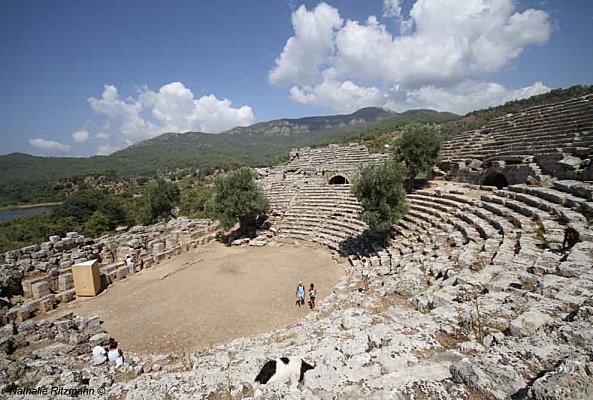 |
|---|
| An experimental device, based on the periaktos (revolving device used to change scenes) described by Pliny, was built. Marble blocks 2m in diameter with deep grooves and a square base at the middle had been found in situ. The device constructed was triangular and turned on the grooves. Judging from the architectural structure, we can understand that the theater had seen three different times. In 150 BC a part of the cavea, in 50 AD the rest of the seats and part of the scene, and between the years 152 and 200 AD the rest of the stage were built. |
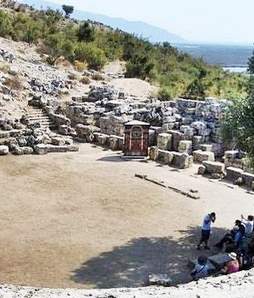 |
|---|

HARBOUR AND CUSTOMS : The harbour which is known as Sülüklü Lake now, played an important role for Caunos to be a commercial city. The harbour which was very deep was protective and a closed type of harbour. Trade ships were able to enter the harbour easily. Today the harbour has turned to a semi marsh. According to the historian and geographer Strabo of Amasya, the entrance of the harbour was closed by a chain. The city of Caunos was built on a peninsula, and the entrance of the harbour would be opened and closed by a chain. The city used two harbors from the Archaic period until the middle of the Hellenistic Period. One of these harbors is to the southeast, called the Southern Harbor, the other is called the Inner Harbor to the northwest of the lesser acropolis. The Southern Harbor was in use from the foundation of the city and which, most probably due to silting ceased to function towards the end of the Hellenistic period. The inner Harbor, which could have been blocked in times of war by a chain across the harbor mouth, served the city until Caunos's latest period of habitation. With the danger of blockage to the mouth of the harbor, because of the silting process of alluvium deposited from the surrounding landscape, the Caunians kept their connection open to the sea via the Calbis(Dalyan) River which provided access to the city for merchant vessels. According to Strabo again, the sources of income of the city were trade salt, salted fish and the slave trade. Based on an inscription found in Xanthos-Lycia, the Cauniens were heroes and rich people and the excavations, starting from the bottom of all structures, also reflected this wealth. |
|---|
We know that the salt of Caunos was very valuable in ancient times. In recent years, we found the salt marsh, by chance, in the lagoon of İstuzu down the beach and was recognized as the first ancient salt marsh in Turkey. However, the silting up of course caused the depletion of the city, is also understood that the following structure. It was used in the newer buildings the blocks of old buildings, known as "reused" . Even the bases of sculptures can be found among the basic blocks. Must be added also that, they too suffered from the epidemic of malaria that was very widespread at that time. |
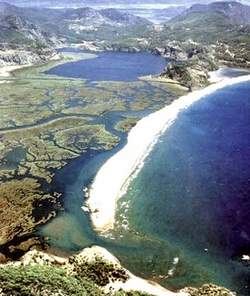 |
|---|
In a port city which had trade relations with the outside, this is inevitable. Dalyan suffered from malaria throughout its history. Until the end of 1940s, the city (and the surrounding) area was subject to malaria. The struggle with the mosquitoes during these years eradicated malaria in Dalyan.  |
|---|
The reason why the people of Caunus had almost a "greenish complexion" enough to cause them to be described as "unhealty" was due to malaria. This pain and suffering is known from a story attributed to Stratonikos, a master of the harp during the Hellenistic Age: when Stratonikos saw the "green faced" people walking the streets of Caunus, he expressed his idea by remarking ; "As are the generations of leaves, so are the generations of men". When the inhabitants of the city complained that they were insulted, he responded: "...how could I dare to call a city unhealthy, where even the dead men walk the streets?..."Strabon xiv, 651.3 Port contour : If our faces back to the old port in the upper terrace of the city, in front of the Byzantine Church, Chomlekchy Tepe (the Potter hill) of is located on the right. On this hill, lie the tombs, the walls of the city that climbs the mountain Balıklar,a castle (from 3.century?) and the western gate. In case of war, the port can be off manually by pulling a chain between the hills. |
|---|
 |
|---|
| On the left of the port is located the hill of 'Küçük Kale "little castle". On the higher points of the hill (Peninsula about 50m high) there are several ruins and a terrace which was used as a sanctuary of Demeter. The small castle which was established for surveillance and to defend against attacks from the sea was attached to the Acropolis by a wall of natural rock. The external part of the city walls and the peninsula was the zone of the old military port that silted up today. HOUSESDuring the archaeological excavations, at the back of the stoa some house remnants which belong to the early Byzantium Period, were found. The housing area is estimated to extend through south and west from the sacred temple. |
|---|
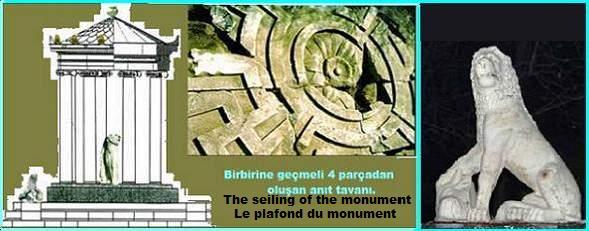 |
|---|
The Monopteros : This structure was built on the flat area in front of the northwestern foot of the small forteress.It consists of two main sections: A round, 5.30m. high superstructure supported by eight columns rising from an approximately square base (7.80x7.85 m. The round open space (cella) flanked by the columns can be accessed from all sides. The female statues unearthed during the excavation must have stood between these columns, while the lion statue, which today stands in the main square of the town of Köyceğiz would originally have stood on one of the corners of this square base. With these features this round structure can be understood to have served as a funerary monument and can be dated to the 1st century AD. |
|---|
The Agora : The space between the port in the south and the sanctuary of Apollo in the north is the Agora of the Port which only ¼ was searched.The Stoa : The "I" shaped, single-naved building which flanks the north side of Agora has a length of 96.82 m and a width of 8.20 m. Because of the absence of shops in its back wall, it is clearly a promenade Stoa. Built in the beginning of 3rd century BC, it would have been a single-storeyed building. The superstructure and the roof made from sandstone and were supported by 44 columns along the front of the stoa, which were carved from the same material. The columns, architrave and frieze blocks were originally painted. The floor was made of compacted soil and the entrance was only through the colonnaded facade facing the harbor. Side entrances were added later, probably during the Early Roman Period. The upper part of the back wall, built of marble courses was also constructed in this period, as the upper part of this wall was originally constructed with sun-dried mud bricks. The remains of the foundations of a long rectangular building exposed beneath the floor of this Stoa must, in all probability, have belonged to a temple built for the same Goddess around the beginning the 4th century BC. La superficie occupée par la Stoa d'aujourd'hui doit avoir été utilisée pour les édifices religieux du début du 5ème siècle avant JC. The area occupied by the Stoa of today must have been used for religious buildings from the early 5th century BC. The Monument of Gratitude, the Donation Monument, the Monument of Licinius Murena at the southeastern end and the Monument of Quintus Vedius Capito at the western end of the Agora, were the major statues that were erected in this harbor agora which shed light on the political history of the city. |
|---|
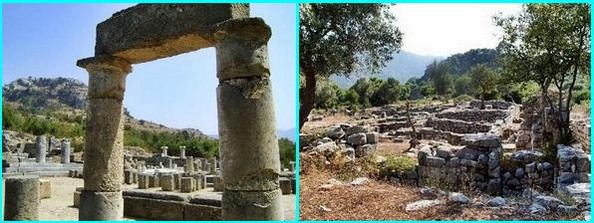 |
This agora was, at the latest, established in the Hellenistic Period or later. Only a quarter of this area has been excavated today. In addition to the official buildings such as the monumental Fountain and the Stoa, excavations have shown that the Agora was embellished with many monuments, statues and groups of statues standing on carved stone bases of various forms, over the course centuries.  None of these statues, which were cast from bronze, were recovered in the excavation. All of these statues were smelted down in the furnace, |
which was built to the right of the Monument of Licinius Murena of late antiquity. The city covers obviously the saddle connecting both the acropoli and the small forteress, to the Sivrihisar and Balyklar hills. This expansion took place at the earliest during Hecatomnid. In the meantime, the city of Caunos began to be built on terraces.  In subsequent periods, while the terraces have been repaired before, new terraces larger were also built. |
|---|
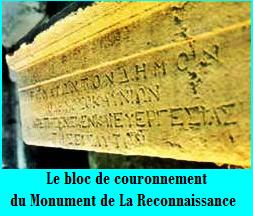 The crown block of the monument of Gratitude |
We learn from the inscriptions unearthed at Caunos and elsewhere, that Caunians,like many local communities, hated Rodians. On the Monument of Gratitude, writes: "The people of Caunos dedicate this statue to the people of Rome for their kindness and their benefits." That is to say, the Cauniens thank Rome to the protection against the Rodians. This is the same monument with which built on the island of Samos, in 188 or 168 BC. On that monument of 7m40 high, a giant statue is representing the Roman people. Here, in Caunos, the sculpture is missing. |
|---|
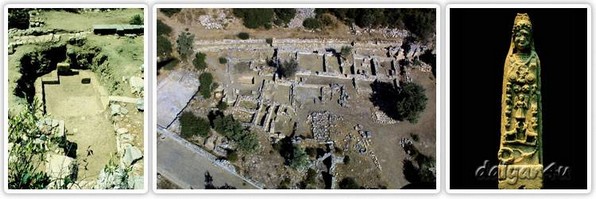 |
|---|
| The Sacred Precinct of Apollo The lower rocky flat area to the west of the Terrace Temple must have been a sacred precinct for the local deity Basileus Kaunios from the beginning of the 4th century BC until the middle of the Roman period, as confirmed by the votive statue bases and stelai found here. Although Apollo is documented as the owner of this area during the Hellenistic Period, this local deity was in fact worshipped in the form of Apollo. |
|---|
The Domed church It is unique and one of the earliest and best preserved examples of this type in Anatolia. It is estimated to have been built in the late 5th century or early 6th century A.D. Called the Great Church, the Basilica is located in the middle of the Palestra terrace, in a central location between the theatre and the Roman baths, the most visited part of the city by tourists. It was made with materials from previous buildings on a foundation of a building belonging to the fourth century, which was probably also used as a place of worship. Existence of churches in Caunos shows that formerly Christians lived here. While Caunos has not been visited by St. Paul, Christianity was not developed until the Byzantine period. At the time of Constantine the Great (337-361), Christianity was adopted as the official religion and the name of the city changed to Hegia-Caunos. The researchers claim that there were an other churche in this region. The smaller one was on the Temple Terrace. (Caldarium room of the Beath was reused also as a church). Thats why, the Byzantine basilica is called the grand church.Because of being one of the oldest and best-preserved churches of its kind in Anatolia and not to have another example, it is also called the Domed church. |
|---|
 |
It has a square plan (14x14.5 metres) and consists of Atrium-narthex - three naves and apse. The entrance is in the west, the sacred direction is in the east. The central nave was closed by a dome and two side aisles with barrel vaults. Each nave has a separate entrance door. 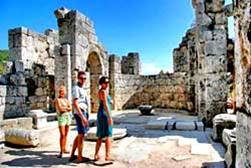 |
|---|
Small chapels were later added on either side. Adjacent to the north wall of the church, the chapel with an apse is located in east-west direction. This is a small sacred building (5.m31x 4.m91), approximately square and its walls are preserved to a height of 0.40m at 1m. It has been used exclusively spolyen-sandstone, and some blocks of marble and the base is covered with marble blocks. |
 The internal parts of the walls were once covered frescoes depicting different themes. This building, after the loss of function, was used as a martyrion with five niches, because the entry was closed and the three bodies of the saints buried there. |
|---|
 |
|---|
In the South Chapel, a surprising find was a very special and beautiful mosaic floor with crater motif (with approximately 1300 years of history), suggesting this was used as a baptistery. The floor has been covered with geotextile fabric and sand, and will eventually be covered with glass so that it can be viewed by visitors. |
|---|
| The Fountain Building : This building, the foundations of which measure 5.36x8.02 m. was built in the middle of the 3rd century BC: in front of a splendid terrace, it faces towards the Agora and there are two columns 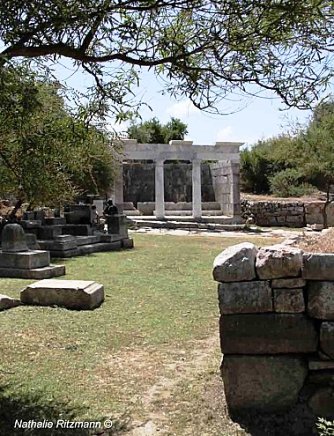 |
situated between the projecting side walls. It served the Caunians through the centuries, as a fountain house, with some changes in its plan. The original building, which was used until the 1st century AD, had a parapet which was located further to the back, approximately in the middle. And the pool was smaller and a shade, a cool shelter, was created in front of the basin. In this fountain house the water flowed through a single spout on the middle axis of the back wall. The women of Caunus, standing on the step in front of the parapet, could fill their jugs by plunging them directly into the basin. |
|---|
| The current state of the building belongs to its latest phase. In this phase, the water basin was enlarged by moving the parapet forwards and the water flowed through five, possibly lion-head, spouts mounted on the back wall. On both sides of the parapet there were two troughs in front and the women of Caunus would leave their jugs under the spouts, on this parapet, to be filled. 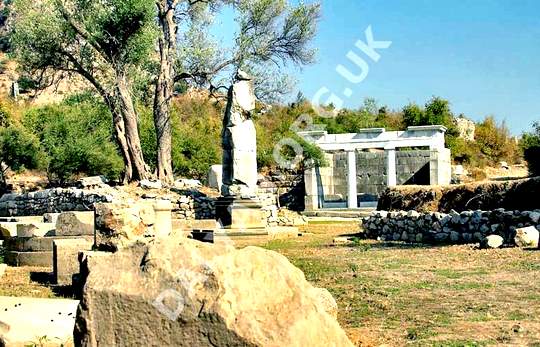 This NYMEHEUM is also known with the name of Roman Emperor, Vespasian (69-79 AD). In the south wall of the monumental fountain there is an inscription. Emperor Vespasian and some records related to the customs are mentioned in this inscription. The inscription is considered an important written document because it contains some information about trade in that period. |
|---|


